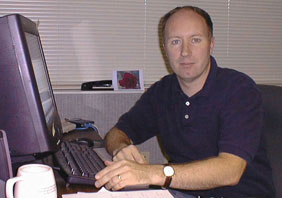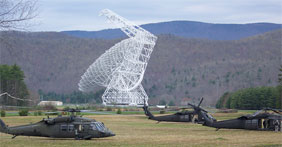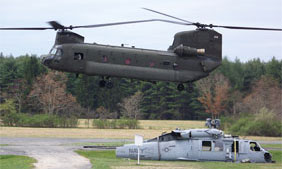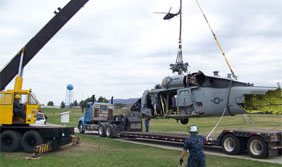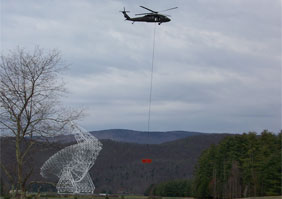NRAO eNews
Volume 3, Issue 4 • May 4, 2010
Upcoming Events
 Cometary Radio Astronomy
Cometary Radio Astronomy
May 17–19, 2010 | Green Bank, WV
 Preparing for ALMA
Preparing for ALMA
May 24, 2010 | 6:00 - 8:00 PM EDT | AAS Meeting Special Session | Miami, FL
 NRAO Proposal Deadline
NRAO Proposal Deadline
June 1, 2010 | 5:00 PM EDT
 12th Synthesis Imaging Workshop NRAO & New Mexico Tech
12th Synthesis Imaging Workshop NRAO & New Mexico Tech
June 8–15, 2010 | Socorro, NM
 ALMA: Extending the Limits of Astrophysical Spectroscopy
ALMA: Extending the Limits of Astrophysical Spectroscopy
January 15–17, 2011 | Victoria, British Columbia
Approved NRAO Science Program: Trimester 2010-B
Tim Bastian, Dale Frail and Toney Minter
The February 2010 call for proposals covered the second trimester of 2010. A total of 210 proposals were received. The GBT and the VLA/VLBA Proposal Selection Committees (PSC) met in the third week of April to review the referee rankings and technical reports for all proposals, with the goal of providing a recommended science program to the NRAO Director’s Office.
A list of the approved EVLA, GBT and VLBA/High Sensitivity Array (HSA) observing programs for Trimester 2010-B will soon be online. The evaluation of the joint NRAO/Fermi and NRAO/Chandra proposals is still underway. These results will be reported separately.
ALMA: Extending the Limits of Astrophysical Spectroscopy
Anthony Remijan and Gerald Schieven
The National Research Council of Canada (NRC), the North American ALMA Science Center (NAASC), and the Center for Chemistry of the Universe (CCU) will jointly host a major science conference titled “ALMA: Extending the Limits of Astrophysical Spectroscopy” in Victoria, British Columbia, 15 – 17 January 2011. The capabilities of new Atacama Large Millimeter/submillimeter Array (ALMA) instrumentation will be highlighted at this meeting via invited science talks in astronomy, astrophysics, and astrochemistry.
Over the next several years, the NRAO research facilities will provide the scientific community with unprecedented advances in high spatial resolution, broadband observing capabilities over frequency ranges that are sparsely covered by other facilities. ALMA will be capable of recording more than 2 GHz of instantaneous bandwidth at high spectral resolution and will routinely deliver high fidelity, high spatial resolution astronomical images. Spectroscopy is a vital tool to improve our understanding of the Universe, enabling scientists to probe physical and chemical environments, investigate kinematics and dynamics, and explore the high red-shift Universe while also obtaining abundances, concentrations, and temperatures of exotic molecular species.
Specific focus areas for this science conference will include:
- The Atomic Universe: Atomic Spectra as Probes of Cool Gas
- The Molecular Universe: Dense Star-forming Gas
- Isotopic Variety in Interstellar Medium
- Our Molecular Origins: Prebiotic Molecules
The Scientific Organizing Committee (SOC) for this meeting includes:
- Gordon Stacey (ASAC, ANASAC, Cornell), Chair
- Al Wootten (NRAO), co-Chair
- Gerald Schieven (NRC), co-Chair
- Anthony Remijan (NRAO), co-Chair
- Doug Johnstone (NRC, ANASAC, ASAC)
- Hsien Shang (Taiwan, ANASAC)
- Deborah Padgett (IPAC, ANASAC)
- Xavier Prochaska (UCSD, ANASAC)
- David Wilner (CfA, ANASAC)
- Yancy Shirley (UofArizona)
- Susanna Widicus (Weaver, Emory University)
- Jean Turner (UCLA)
- Rachel Friesen (NRAO)
- Brooks Pate (UVa)
We sincerely hope you will consider attending this conference and join the community in realizing the full potential of ALMA!
View additional information about this conference.
NRAO Student Observing Support (SOS) Program
Jeff Mangum
The NRAO Student Observing Support (SOS) program is designed to support research by graduate and undergraduate students at U.S. universities and colleges. This program's purpose is to strengthen the proactive role of the NRAO in training new generations of radio telescope users. Applications for SOS program grants are made as supplements to the normal NRAO proposal submission process. Regular proposals submitted for the Green Bank Telescope (GBT), the Very Long Baseline Array (VLBA) and the Expanded Very Large Array (EVLA) are eligible for funding. Large proposals for the VLBA, GBT, EVLA, and any combination of these telescopes are also eligible. General information on the program structure and background information is available on the Student Observing Support (SOS) Program web page.
ALMA Construction Update
Al Wootten
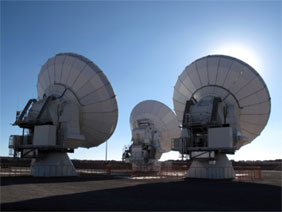
Fig.1: Three antennas in a compact commissioning array at the Array Operations Site (AOS). Antennas sit on stations (J504, J505, N604) will eventually accommodate 7m antennas. Credit: ALMA (ESO/NAOJ/NRAO).
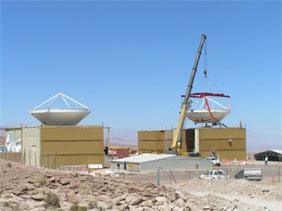
Fig.2: The dish structure is lowered onto the pedestal and cabin structures on an AEM antenna on the right. The procedure has already been completed for the antenna at left. Credit: R. Hills, ALMA (ESO/NAOJ/NRAO).
On 1 April, ALMA antenna DV02 was moved to a foundation at the 5000m elevation Array Operations Site (AOS) that is slated to eventually host a 7m antenna in the Atacama Compact Array (ACA). This current array configuration at the AOS has two 30m baselines and one 18m baseline (Fig 1). Atmospheric variations affect signals less on these shorter baselines, which are shorter than the 100+m AOS baselines previously available. Cooler autumn temperatures also ensure a somewhat lower turbulent component in the atmosphere. Measurements at the 2900m elevation Operations Support Facility (OSF) are limited to tower beacons at low angular elevation. A key April commissioning goal was therefore to verify antenna performance at the high AOS elevations and in cooler, windier weather.
Antenna performance is validated by astro-holography: holography using astronomical sources. Planets are bright but scarce and many are resolved even on short baselines at 3mm and shorter wavelengths. Quasars are more abundant but only moderately bright. These factors limit sensitivity to surface errors on meter scales. Initial tests show that the telescopes are performing as predicted by models based on lower elevation measurements at the warmer OSF; these models include gravitational sag of the telescope structure. Smaller scale surface errors may be measured through observations of distant side-lobes of bright sources; Sun and Moon observations were acquired to constrain this. With atmospheric distortion minimized, sensitive tracking tests were carried out. Other tests focused on phase stability and other ALMA system characterizations. In the compact array, the telescopes are powered by the first phase of the single AOS power system rather than by multiple generators.
New antennas and electronics were accepted, integrated and tested at the OSF. One or more of the four antennas there will be transported to the AOS for incorporation into the array during May, even as newly assembled antennas will be accepted by the project into the OSF compound from the manufacturers for integration and test. At present, the four antennas at the OSF are deployed with two in interferometric testing and two in total power tests, eventually to be incorporated in the interferometer as its elements migrate to the AOS.
Assembly continues at the contractor’s camps. Notably, the dish structures of two AEM antennas, fully tiled with their reflector panels, were mounted onto their pedestal and cabin structures during the month. Further assembly is underway.
The fifth issue of the Joint ALMA Observatory Newsletter is now available.
Funding Received for Wideband Operation of the VLBA
Craig Walker
The Very Long Baseline Array (VLBA) Sensitivity Upgrade Project has received a grant from the National Science Foundation under the Major Research Instrumentation program to fund the purchase of the recording media and correlator computational resources needed to reach a sustained bit rate of 2 Gbps. This is a major step toward the project goal of reaching 4 Gbps. The new funding enables a factor of eight bandwidth increase over the current sustainable rate, yielding nearly a factor of three increase in sensitivity on continuum sources.
We expect that a small portion of these funds will be spent quickly to make the current maximum bit rate of 512 Mbps the standard bit rate for all continuum projects. Projects already in the queue will be given the opportunity to submit schedules with increased bandwidth. For the 1 June 2010 proposal deadline, 512 Mbps will be offered as the default continuum bandwidth. The rest of the funds will be spent once the new Roach Digital BackEnds (RDBEs) and Mark5C recording systems required for higher bit rates are ready to deploy in late 2010.
New VLBA correlator capabilities in Trimester 2010-C
Adam Deller
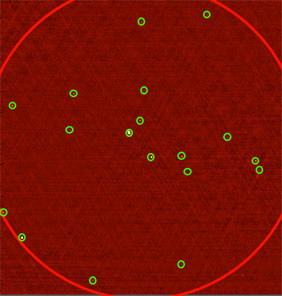
A cutout from the 1.4 GHz VLA FIRST radio survey, with the VLBA primary beam at 1.4 GHz overlaid in red and FIRST sources highlighted in green. Note that the green circles are still several times larger than the typical VLBA field of view. Correlating at the positions of these 18 sources using the new multi-field, single-pass capability of DiFX would be ~ 7 times as fast as 18 individual correlations. For deeper or more crowded fields, with more sources per primary beam, the advantage of the multi-field correlation grows even greater.
The DiFX software correlator, which has been used for VLBA operations since December 2009, will support two new observing modes for trimester 2010-C: multiple phase centers, and spectral zooming. Each is described further below.
Multiple phase centers
In a single correlator pass, DiFX will now be able to produce multiple phase centers. The effective VLBA field of view is usually limited to less than a thousandth of the available primary beam area due to time and bandwidth smearing, which meant that imaging widely separated sources within the primary beam required multiple correlator passes. DiFX now allows a near-arbitrary number of fields (up to 500 has been tested) in a single correlator pass, using a uv-shift inside the correlator. This new mode consumes ~ 2.5x more correlator resources than a "normal" correlation due to the higher initial frequency resolution required to support the uv-shifting, but each additional field of view is effectively free; for example, correlating 200 fields-of-view carries only a 20% overhead compared to 2 fields-of-view. Figure 1 shows how this can be applied to image multiple sources detected at lower resolution with the VLA.
Spectral zooming
Selection of a subset of the spectral channels in a recorded band will now be possible within the correlator. This enables faster post-processing and reduced visibility dataset sizes when high spectral resolution is desired in a small section of a wide recorded band. The main beneficiary of this mode of operations will be maser astrometry with faint in-beam calibrators. Previously, attaining high spectral resolution on maser targets required either the use of narrower recorded bands, which reduces sensitivity to faint continuum in-beam calibrators, or the production of extremely large visibility datasets. With this new DiFX capability, wide bands can be retained for more sensitivity on in-beam calibrators, but spectral selection can be used to create a dataset of high resolution but reasonable size on the maser target. Selecting spectral regions around multiple maser lines from a single wide band will also be possible. The Observational Status Summary will be updated to provide more information on these new DiFX capabilities before the call for proposals is issued for trimester 2010-C.
Dale Frail Awarded Guggenheim Fellowship
Fred K.Y. Lo
I am very pleased to announce that NRAO scientist Dale Frail has been awarded a prestigious Fellowship from the Guggenheim Memorial Foundation. The Guggenheim Foundation describes its fellowships as "mid-career" awards "for men and women who have already demonstrated exceptional capacity for productive scholarship or exceptional creative ability in the arts."
Dale has been a scientist at the NRAO for more than 20 years, first as a postdoctoral fellow, and then as a staff scientist. He received his bachelor's degree in physics from Acadia University in Nova Scotia, and his Ph.D. in astronomy from the University of Toronto.
Dale is best known for his landmark contributions to the understanding of gamma ray bursts, making critical measurements that provided key insights into the mechanisms of these super-energetic and once-mysterious explosions. He also has made important contributions to the understanding of other astronomical phenomena, including pulsars and their neighborhoods, supernova remnants, and magnetars. In 1992, he was the co-discoverer, with Alex Wolszczan, of the first planets outside our own solar system.
Chosen from some 3,000 applicants, Dale is one of 180 recipients of this year's Guggenheim Fellowships. The fellowships were established in 1925 and past recipients include photographer Ansel Adams, author Saul Bellow, former Secretary of State Henry Kissinger, and chemist Linus Pauling. More than a hundred Guggenheim Fellows have subsequently won Nobel Prizes, and others have received Pulitzer Prizes and other honors.
As a Guggenheim Fellow, Dale intends to intensify his research on pulsars, cosmology, and gamma ray bursts, using the Expanded Very Large Array to advance the frontiers of knowledge.
Please join me in congratulating Dale on this well-deserved honor that recognizes not only his past achievements but also his potential for exciting scientific work in the future. I am very proud to see one of our scientists receive such a great honor!
A Navy Helicopter Salvage Operation in the Shadow of the GBT
Mike Holstine
On Tuesday, 20 April, about 20 US Army National Guard (ANG) and Navy personnel arrived at the Green Bank site to begin a Downed Aircraft Recovery Mission for an MH-60S Blackhawk helicopter that crashed in the mountainous terrain of Pocahontas County in March. The weather was much kinder to the crews of servicemen over the next two days than it had been only a month earlier, when 5-8 feet of snow had required an extraordinary rescue effort, led from the NRAO Green Bank facility, that safely recovered the 17 passengers and crewmembers of the ill-fated helicopter over a two-day period without serious injuries.
This recovery effort employed three Blackhawks and one CH-47 twin rotor Chinook, the latter the lifting aircraft for the remains of the downed airframe. After a briefing on Tuesday night, and weather concerns dictating the final “go no-go” decision, military personnel settled into the NRAO dormitory for a night’s sleep.
On Wednesday, a briefing at 09:00 cleared the operation to start, and the helicopters lifted off from the airstrip area at ~ 10:30. The Chinook was fitted with an aerial lift line and flew to the crash site, about 8 miles NW of the Green Bank Telescope (GBT). Flight paths were determined to ensure that no telescopes, structures, homes or active areas were crossed during the operation.
The Blackhawks transported large metal baskets to the mountain so that ground crews could accumulate and load all of the smaller bits of the aircraft that were scattered across the crash site. At about 11:45, all three ANG Blackhawks accompanied the Chinook, downed Blackhawk hanging below, back to the airstrip area while several employees and local residents looked on. The salvage craft was lowered to the ground, the NRAO crane picked the airframe from the ground and loaded it onto a lowboy Navy tractor-trailer. The GBT forklift loaded all of the basket parts into a Navy cargo truck. By 18:00, the operation was complete and all personnel were headed back to their respective stations.
The professionalism and appreciation shown by our military personnel was impressive, and the Green Bank employee contributions to this operation were very much appreciated. We particularly want to thank Dave Vandevender for operating the crane and H.A Taylor for operating the forklift. It was an honor to assist the men and women of the US military services, and this operation closed an eventful month at the Green Bank site for both the ANG and the Navy. Many of them promised to come back and visit under less strenuous circumstances.
From the Archives
Ellen Bouton

About this month's photograph: On 26 January 1968, the NRAO 140-foot telescope was used to observe the first lunar occultation of the Galactic Center source, Sgr A, a rare event that occurs only in windows of ~ two years duration every two decades. The project was a collaboration between (standing, from left to right) Frank J. Kerr, Joseph H. Taylor and "Sandy" Aa. Sandqvist. NRAO telescope operator, Tom Carpenter is seated at the 140-foot control table. Simultaneous observations were performed of the continuum emission at 235, 256, 405, 1420, and 1666 MHz; and of the line emission and absorption from the 21-cm HI line and the two main 18-cm OH lines. This series of lunar occultation observations (1968-1970) with the 140-foot telescope resulted in the discovery that Sgr A consists of at least two major continuum components, now known as Sgr A West and Sgr A East, immersed in a whirling complex of atomic and molecular gas. Thanks to "Sandy" Aa. Sandqvist for both the photograph and the descriptive note.
From the Archives is an ongoing series illustrating NRAO and U.S. radio astronomy history via images selected from our collections of individuals' and institutional papers. If readers have images they believe would be of interest to the Archives, please contact Ellen Bouton.
Career Opportunities
New Postings
Co-op Student: The Electronics Division in Socorro, NM is seeking a full-time student (enrolled for the Spring 2010 semester) to work 40 hours providing support in computer programming, electronic design and/or testing. This particular work assignment will involve performing RFI and EMC testing at the Very Large Array.
Division Head (Head, JAO Data Mgmt Group): The Joint ALMA Observatory (JAO) invites applications for the position of Head of the Joint ALMA Observatory Data Management Group. The Data Manager will participate in tests and development of the pipeline and software tools used for quality assurance, data delivery and scheduling as well as plan science operations, pipeline operations, archive operations and participate in the setup of the archives before the start of ALMA early science operations in 2011.
Systems Engineer I: The Joint ALMA Observatory (JAO) is seeking a System Engineer to work on the JAO System Engineering team, which is responsible for the definition and execution of system engineering activities across the project.
Technical Specialist II: The Electronics Division in Socorro, NM is seeking a Technical Specialist to assemble, calibrate, test, analyze, troubleshoot and/or repair the Digital Transmission System and Receiver modules.
EVLA Postdoc: The Expanded Very Large Array (EVLA) will begin offering Shared Risk Observing to the user community in March 2010. NRAO invites applications for an EVLA Commissioning Postdoc position which will be 50% independent research, and 50% assisting with the scientific commissioning of the EVLA. The successful candidate will help define observing procedures, test telescope performance, develop calibrator databases and calibration pipelines, and to assist with the development and testing of other hardware or software capabilities needed for the successful operation of the EVLA.
Software Engineer II (CASA Programmer): The Common Astronomy Software Applications (CASA) group has an immediate need for development of high-performance computing algorithms/packages and cluster environment support. The Software Engineer will develop high-performance computing algorithms/packages and cluster environment support.
Software Engineer II: The Software Development Division in Green Bank, WV is seeking a Software Engineer to help design, develop, implement, and support the Dynamic Scheduling System for the Green Bank Telescope. The Dynamic Scheduling System is broken into three major components: a web application built with the Django web development framework, a series of custom user interfaces built with Ext GWT, and the core scheduler implemented in the functional programming language, Haskell. The Dynamic Scheduling team uses agile software development methods and automated unit testing to provide a working system for sponsors at every step of system development.

 Zoom
Zoom